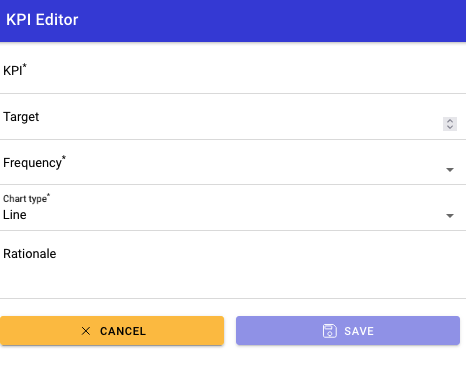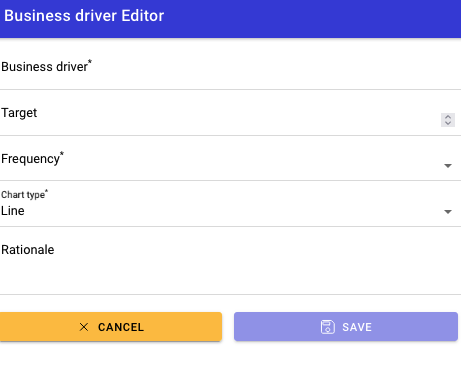Keeping and enabling the score
Choice 1A: Measures (metrics)
StrategyCAD guide to better strategy - faster
"You should always know how you're doing against your metrics.
You should always have a weekly review meeting every week.
.”
Sam Altman, CEO OpenAI former president Y Combinator

In this chapter
Define Key Performance Indicators and Business drivers
Differentiate between a KPI and a Business driver
Define your KPI(s).
Define your business drivers.
Introduction
In this section you can consider your Key Performance Indicators (KPI's) and what measures in your control you can use to guide resource allocations to achieve your KPI's.
Key Performance Indicators
Key performance indicators (KPIs) are metrics that are used to measure and track the performance of your business or specific aspect of your business. They are used to determine whether a your business is meeting its goals and objectives, and to identify areas for improvement.
KPIs can be used at various levels within an organization, from overall business performance to specific functions or departments. They may be financial metrics, such as revenue or profit, or non-financial metrics, such as customer satisfaction or employee retention.
Some common examples of KPIs include:
- Sales performance: metrics such as revenue, sales growth, and customer acquisition rate
- Financial performance: metrics such as profit margin, return on investment (ROI), and cash flow
- Marketing performance: metrics such as website traffic, lead generation, and conversion rate
- Customer satisfaction: metrics such as Net Promoter Score (NPS) and customer retention rate
- Employee performance: metrics such as productivity, retention rate, and employee satisfaction
KPIs should be specific, measurable, and ambitiously achievable. They should be aligned with your aspirations. By regularly tracking and analyzing KPIs, your business can gain insights into its performance and identify opportunities for improvement.
Achieving KPIs often means working to improve business drivers (leading indicators) that will drive KPI’s (lagging indicators). You will be able to look at business drivers in the next section.
KPI's in StrategyCAD™

View of KPI's in StrategyCAD linked to a value proposition.

StrategyCAD™ KPI editor to add or update a KPI
Define the outcome / result (not output or activity) to be measured
Define your target
Define how frequently the KPI will be measured
Outline the rationale for this KPI, why is it important to measure, relevance to aspirations
Record the measures at the scheduled frequency and monitor the trend. There may be some ups and downs, but the trend should be toward the target.
Enabling the score - Business drivers
In the previous section you recorded your KPI’s.
KPI’s are the scores on the scoreboard.
However, KPI’s are not in your direct control.
You and your teams cannot directly create revenue growth,
or customer satisfaction or profitability.
Business drivers are the activities that you can control and correlate
to optimize the potential of achieving a KPI.
For example, you might know that if your business does new customer
follow-ups at 1 week and 1 month post sale then those customers report
higher satisfaction and retention.
Therefore, a business driver which sets a target on customer
follow-ups at both 1 week and 1 month is in the control of the business and
influences one or more KPI’s.
For other KPI’s the business drivers that will facilitate their
achievement might be unknown or uncertain.
This is where business drivers come into value.
You can speculate / experiment on activities that might be expected to influence KPI.
Evaluate these activities to determine or not correlation with KPI’s.
If a proposed business driver cannot be correlated (after a reasonable sample size)
to any KPI then it might be a waste of the resources that it consumes.
You can determine if there is a correlation
if the trend line between the KPI and business driver trend in same direction (positive
correlation) or in the negative direction (negative correlation). If the business driver
and the KPI have no trend line correlation, then the results will show no comparable trend.
If it can be correlated, then based upon the business driver performance the
business can anticipate what range of achievement will be achieved for the KPI.
Relationships between business drivers and KPI’s may of course change over time.
A business driver might work for a year or two and then begin to show a change in
correlation (increase or decrease). Tracking relationships between business
drivers and KPI’s can be useful in making resource decisions.

View of business drivers in StrategyCAD linked to a value proposition.

StrategyCAD™ Business driver editor to add or update a Business driver
Define the activity expected to enable a KPI
Define your target
Define how frequently the business driver will be measured. Needs to more frequently than the KPI.
Outline the rationale for this business driver, its' relevance to KPI.
Record the measures at the scheduled frequency and monitor the trend. There may be some ups and downs, but the trend should be toward the target.
Next step
Now that you have defined your candidate KPI's and business drivers, time to move on to the next choice - Choosing where to play.
Note you may need to adjust your aspiration and measures in response to subsequent choices.
You can try StrategyCAD™ free for 30 days to build your high performance strategy
Try it Learn moreGet started by creating your aspirations in StrategyCAD™